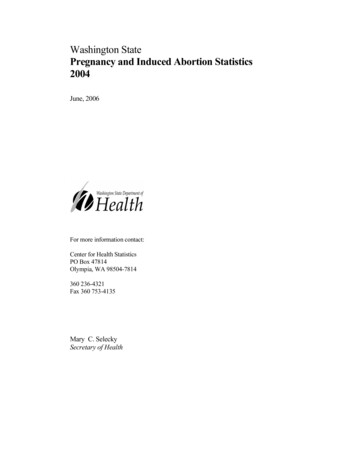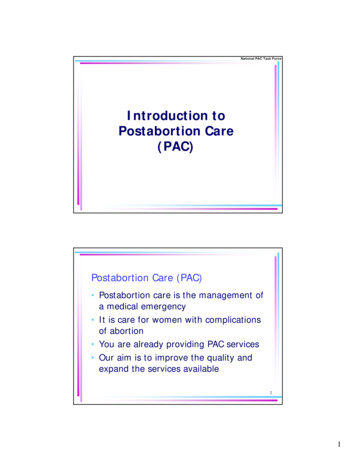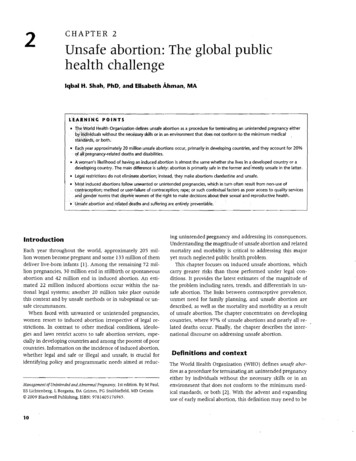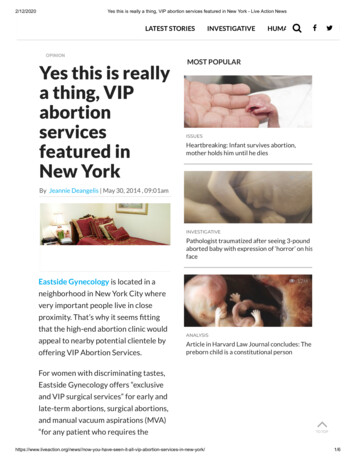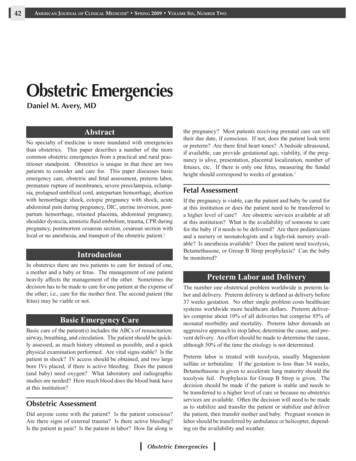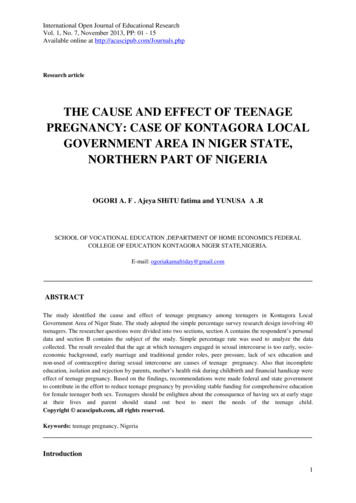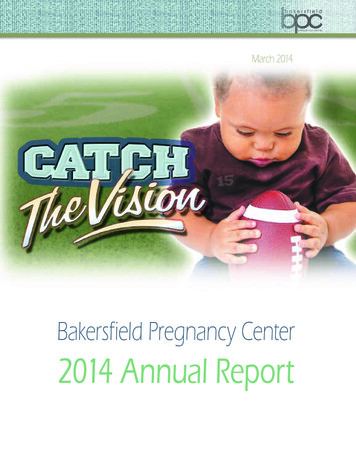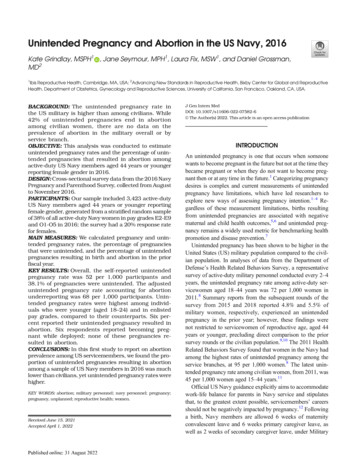
Transcription
Unintended Pregnancy and Abortion in the US Navy, 2016Kate Grindlay, MSPH1 , Jane Seymour, MPH1, Laura Fix, MSW1, and Daniel Grossman,MD21Ibis Reproductive Health, Cambridge, MA, USA; 2Advancing New Standards in Reproductive Health, Bixby Center for Global and ReproductiveHealth, Department of Obstetrics, Gynecology and Reproductive Sciences, University of California, San Francisco, Oakland, CA, USA.BACKGROUND: The unintended pregnancy rate inthe US military is higher than among civilians. While42% of unintended pregnancies end in abortionamong civilian women, there are no data on theprevalence of abortion in the military overall or byservice branch.OBJECTIVE: This analysis was conducted to estimateunintended pregnancy rates and the percentage of unintended pregnancies that resulted in abortion amongactive-duty US Navy members aged 44 years or youngerreporting female gender in 2016.DESIGN: Cross-sectional survey data from the 2016 NavyPregnancy and Parenthood Survey, collected from Augustto November 2016.PARTICIPANTS: Our sample included 3,423 active-dutyUS Navy members aged 44 years or younger reportingfemale gender, generated from a stratified random sampleof 38% of all active-duty Navy women in pay grades E2-E9and O1-O5 in 2016; the survey had a 20% response ratefor females.MAIN MEASURES: We calculated pregnancy and unintended pregnancy rates, the percentage of pregnanciesthat were unintended, and the percentage of unintendedpregnancies resulting in birth and abortion in the priorfiscal year.KEY RESULTS: Overall, the self-reported unintendedpregnancy rate was 52 per 1,000 participants and38.1% of pregnancies were unintended. The adjustedunintended pregnancy rate accounting for abortionunderreporting was 68 per 1,000 participants. Unintended pregnancy rates were highest among individuals who were younger (aged 18–24) and in enlistedpay grades, compared to their counterparts. Six percent reported their unintended pregnancy resulted inabortion. Six respondents reported becoming pregnant while deployed; none of these pregnancies resulted in abortion.CONCLUSIONS: In this first study to report on abortionprevalence among US servicemembers, we found the proportion of unintended pregnancies resulting in abortionamong a sample of US Navy members in 2016 was muchlower than civilians, yet unintended pregnancy rates werehigher.KEY WORDS: abortion; military personnel; navy personnel; pregnancy;pregnancy, unplanned; reproductive health; women.Received June 15, 2021Accepted April 1, 2022J Gen Intern MedDOI: 10.1007/s11606-022-07582-6 The Author(s) 2022. This article is an open access publicationINTRODUCTIONAn unintended pregnancy is one that occurs when someonewants to become pregnant in the future but not at the time theybecame pregnant or when they do not want to become pregnant then or at any time in the future.1 Categorizing pregnancydesires is complex and current measurements of unintendedpregnancy have limitations, which have led researchers toexplore new ways of assessing pregnancy intention.1–4 Regardless of these measurement limitations, births resultingfrom unintended pregnancies are associated with negativematernal and child health outcomes,5,6 and unintended pregnancy remains a widely used metric for benchmarking healthpromotion and disease prevention.7Unintended pregnancy has been shown to be higher in theUnited States (US) military population compared to the civilian population. In analyses of data from the Department ofDefense’s Health Related Behaviors Survey, a representativesurvey of active-duty military personnel conducted every 2–4years, the unintended pregnancy rate among active-duty servicewomen aged 18–44 years was 72 per 1,000 women in2011.8 Summary reports from the subsequent rounds of thesurvey from 2015 and 2018 reported 4.8% and 5.5% ofmilitary women, respectively, experienced an unintendedpregnancy in the prior year; however, these findings werenot restricted to servicewomen of reproductive age, aged 44years or younger, precluding direct comparison to the priorsurvey rounds or the civilian population.9,10 The 2011 HealthRelated Behaviors Survey found that women in the Navy hadamong the highest rates of unintended pregnancy among theservice branches, at 95 per 1,000 women.8 The latest unintended pregnancy rate among civilian women, from 2011, was45 per 1,000 women aged 15–44 years.11Official US Navy guidance explicitly aims to accommodatework-life balance for parents in Navy service and stipulatesthat, to the greatest extent possible, servicemembers’ careersshould not be negatively impacted by pregnancy.12 Followinga birth, Navy members are allowed 6 weeks of maternityconvalescent leave and 6 weeks primary caregiver leave, aswell as 2 weeks of secondary caregiver leave, under Military
Kelly et al.: Unintended Pregnancy and Abortion in the NavyParental Leave Program.12 While this leave is more than manyemployers offer in the USA, the Defense Advisory Committeeon Women in the Services, a Department of Defense federaladvisory committee appointed by the Secretary of Defense toprovide advice and recommendations related to servicewomenin the Armed Forces, states this policy “falls short of mitigating the considerable physical and mental challenges[servicemembers] face trying to achieve a reasonable worklife balance” and that work-life balance challenges are furtherexacerbated by deployments, repeated moves, and distancefrom family support systems. 1 3 Because pregnantservicemembers cannot remain in certain military positionsor roles, they lose work time during and after pregnancy, andmust also be evacuated if deployed and returned to their homestation. 14 Prior research has found concerns amongservicemembers that pregnancy and associated stigmas, lostwork time, and deployment disruptions could harm their careers,15–18 despite official guidance that pregnancy will not bethe basis for downgrading marks or adverse career impacts.12For servicemembers seeking to terminate a pregnancy, federal law only allows abortion provision and TRICARE insurance coverage in cases of rape, incest, and life endangermentof the pregnant person.19 Most servicemembers must thereforeseek abortion care outside the military health care system.Research has found numerous barriers to servicemembersseeking abortion care on their own, including legal, logistical,and financial barriers, concerns about confidentiality, and fearof negative career impacts.15–17 In the civilian population, thepercentage of unintended pregnancies that resulted in abortionwas 42% in 2011.11 There are no published data on theprevalence of abortion among US servicemembers with unintended pregnancies.The Navy Pregnancy and Parenthood Survey, conductedbiennially since 1988, is designed to collect data for evaluatingpregnancy policies on parenthood and pregnancy for the Department of the Navy,20 and some survey rounds include aquestion on pregnancy outcome, including abortion. Thisanalysis was conducted to estimate unintended pregnancyrates and the percentage of unintended pregnancies that resulted in abortion among active-duty US Navy members aged 44years or younger reporting female gender in 2016.MATERIALS AND METHODSData SourceCross-sectional data from the 2016 Navy Pregnancy and Parenthood Survey were used to calculate pregnancy and unintended pregnancy rates, the percentage of pregnancies thatwere unintended, and the percentage of unintended pregnancies that resulted in birth and abortion in the prior fiscal yearamong active-duty US Navy members aged 44 years or younger reporting female gender. The survey was conducted by theNaval Air Warfare Center Training Systems Division(NAWCTSD) Air Branch 4635 (Manpower and PersonnelJGIMStudies).20 The data used for this analysis were obtained viaFreedom of Information Act request from the Naval Air Warfare Center.Survey Design, Sampling, and Data CollectionData were collected from August to November 2016. Thetarget population included a stratified random sample of22,924 Navy women (38% of all active-duty Navy women)and 9,665 Navy men (4% of all active-duty Navy men) in paygrades E2-E9 and O1-O5. Participants received a survey invitation letter and two reminder letters at their command addressand three reminder emails. The survey was conducted online.Overall, 4,802 participants reporting male or female gendercompleted the survey, with a 20% return rate for females aftercorrecting the sample size for return-to-sender errors.20The survey asked a common core set of questions to allparticipants on retention influencers, parenthood, family planning, sabbaticals, attitudes toward birth control and health careproviders, and adoption leave. To maintain anonymity ofrespondents, the survey manager removed all login information from the data before analysis20 and this information wasnot included in our dataset.Inclusion CriteriaWe restricted our sample to participants of reproductive age,aged 44 years or younger, reporting female gender. Genderwas assessed by the question, “What is your gender?” fromwhich respondents could select “male” or “female.”OutcomesOur outcomes of interest were unintended pregnancy andunintended pregnancy that resulted in abortion in the priorfiscal year. Pregnancy in the prior fiscal year was measured byanswering “yes” to the question, “Did you become pregnantbetween 1 October 2014 and 30 September 2015? (Do NOTcount pregnancies that began before 1 October 2014 eventhough you were pregnant on that date.).” One additionalparticipant was coded as having a pregnancy during the priorfiscal year as they reported a pregnancy in that time period inresponse to a question about how long ago their most recentpregnancy during Navy service occurred.Unintended pregnancy in the prior fiscal year was measuredby answering “yes” to the question, “Did you have an UNPLANNED pregnancy between 1 October 2014 and 30 September 2015? Note: For this survey, a planned pregnancy isone that you wanted at that time (i.e., you intentionally becamepregnant.).”Participants were also asked a series of questions about theirmost recent pregnancy since entering the Navy, including onthe pregnancy outcome, whether they were deployed whenthey became pregnant, and whether they were using birthcontrol at the time of the pregnancy and if not, why not. Werestricted analyses of these variables to participants who
JGIMKelly et al.: Unintended Pregnancy and Abortion in the Navyreported an unintended pregnancy in the prior fiscal year andassumed that reporting on most recent pregnancy among theseindividuals referred to the pregnancy in the prior fiscal year.The outcomes of participants’ unintended pregnancies inthe prior fiscal year (abortion or birth) were assessed by thequestion, “What was the outcome of [your most recent] pregnancy?” We excluded participants who reported their unintended pregnancy outcome as currently pregnant, having had amiscarriage, or having had an ectopic pregnancy so as toinclude pregnancy outcomes determined by the participant.Participants were coded as having had an abortion if theyreported their most recent pregnancy outcome as “abortion.”Participants were coded as having had a birth if they reportedtheir most recent pregnancy outcome as “live birth (deliveryafter 36th week of gestation),” “premature birth (deliverybetween the 20th through 36th week of gestation),” or“stillbirth.”CovariatesParticipants were asked demographic questions on their current age, marital status, and pay grade, as well as their deployment status when they became pregnant; race and ethnicityquestions were not asked in the survey. Covariates wereselected based on availability in the dataset, associations withunintended pregnancy found in prior research withservicemembers,8,21,22 and a priori interest in the impacts ofdeployment status on pregnancy outcomes. We coded participants’ pay grades as enlisted (E1-9) or officer (W2-5, O1-O7or above); two respondents did not answer this question;however, a variable for Navy rate that was included in thedataset indicated they were in the enlisted pay grade and wecoded them accordingly. Deployment at the time of unintended pregnancy was measured by answering “deployed” to thequestion, “Where was your [Navy] unit in the operationalcycle when you [most recently] became pregnant?”Data AnalysesDescriptive statistics were calculated with Stata StatisticalSoftware version 15.1 (StataCorp, College Station, TX). Missing data (nine participants who did not respond to the questions on prior pregnancy; one missing entry for two covariates;one missing entry for birth control use at time of most recentpregnancy) were excluded and the sample size for our outcomes of interest varied based on item response and surveyskip patterns. The STROBE guidelines were used in reportingour study findings.23 This study was approved by theAllendale Investigational Review Board.For the prior fiscal year overall and by background characteristics, we calculated the total number of pregnancies, thenumber of pregnancies that were unintended, and the percentage of pregnancies that were unintended. We divided thenumber of pregnancies and unintended pregnancies by thetotal sample population to obtain self-reported pregnancyand unintended pregnancy rates per 1,000 participants, byparticipants overall and by available background characteristics, including age group (18–24, 25–29, 30–44), relationshipstatus (single, never married; divorced, widowed, separated;married), and pay grade (enlisted, officer); 95% confidenceintervals (CIs) were also calculated for unintended pregnancyrates overall and by background characteristics.We also calculated adjusted unintended pregnancy rates toaccount for underreporting of abortion. To do this, we employed methodology previously used to measure unintendedpregnancy in the civilian population and the US military.22Using this methodology, we increased the self-reported number of pregnancies reported by 11.9% (to mirror householdsurvey findings that nearly half of abortions are underreported,reflecting 11.9% of the total number of reported pregnancies);95% of these additional pregnancies were assumed to beunintended, as they represented induced abortions.22 Weadded these additional unintended pregnancies to the unintended pregnancies that were self-reported to calculate theadjusted unintended pregnancy rate.Finally, we calculated the percentage of self-reported unintended pregnancies in the prior fiscal year that resulted in birthand abortion, along with 95% CIs for these overall and bybackground characteristics, including age group, relationshipstatus, pay grade, and deployment status at the time of thepregnancy.RESULTSAfter excluding those who did not identify their gender asfemale (n 1,165) and who were over the age of 44 (n 214),our sample included 3,423 participants. Most participantswere aged 30–44 years (range: 19–44 years), married, and inthe enlisted pay grade. Overall, the unintended pregnancy ratewas 52 per 1,000 participants (95% CI: 45–60) and 38.1% ofpregnancies (95% CI: 33.8–42.6%) were unintended in 2016.The adjusted unintended pregnancy rate accounting for abortion underreporting was 68 per 1,000 participants. Unintendedpregnancy rates were highest among younger individuals aged18–24 and enlisted individuals, compared to their counterparts. (See Table 1.)Of the 178 participants who reported an unintended pregnancy in the prior fiscal year, 150 reported their pregnancyoutcome as birth or abortion and were included in our analysesof pregnancy outcomes (excluded from this analysis were twowho reported ectopic pregnancy, eight who were still pregnant, and 18 who reported miscarriage). Among these 150respondents with an unintended pregnancy in the prior fiscalyear, only nine (6.0%, 95% CI: 3.1–11.2%) reported that thepregnancy resulted in abortion. No unintended pregnanciesresulting in abortion were reported by individuals who weredeployed when they became pregnant. (See Table 2.)Sixty percent of participants with an unintended pregnancyin the prior fiscal year (106/177) reported they were not usingcontraception at the time of their unintended pregnancy.
JGIMKelly et al.: Unintended Pregnancy and Abortion in the NavyTable 1 Pregnancy Rates and Percentage That Were Unintended in the Prior Fiscal Year, Among US Navy Members Aged 44 Years orYounger Reporting Female Gender in 2016 (N 3,414)CharacteristicAll femalesAllparticipantsNumber of pregnanciesPercentage ofpregnancies thatwere unintendedPregnancy rate per 1,000 servicemembersn ed*3,414(100%)46717838.1%13752 (95% CI:45–60)68755269.3%10371 (95% CI:55–92)60 (95% CI:47–78)40 (95% CI:32–50)83Age group (in years)18–24729 (21%)25–29926 (27%)1195647.1%12930–441,759 (52%)2737025.6%1551,205 (35%)654975.4%547557Relationship statusSingle, nevermarriedDivorced,widowed,separatedMarried422 (12%)373081.1%881,786 (52%)3649826.9%20455 (95% CI:45–66)78Pay gradeEnlisted1,945 (57%)27915254.5%14394Officer1,469 (43%)1882613.8%12878 (95% CI:67–91)18 (95% CI:12–26)41 (95% CI:31–53)71 (95% CI:50–100)478132Columns may not tally to 100% owing to missing values*Adjusted for abortion underreportingCI confidence intervalAmong these participants (n 106), 27.4% reported they ortheir partner did not want to use birth control; 17.0% thoughtthey or their partner was infertile; 3.8% were not comfortablediscussing or getting birth control, and 2.8% cited personal orreligious beliefs; 49.1% reported some other reason for notusing contraception at the time of pregnancy (the data on otherreasons were not included in our dataset). Data not shown.DISCUSSIONIn this first study to report on abortion prevalence among USservicemembers, we found that while unintended pregnancyrates among this sample of US Navy servicemembers in 2016remained higher than in the civilian population, the proportionof self-reported unintended pregnancies resulting in abortionwas much lower (6.0%) compared to civilians (42%11).The lower proportion of unintended pregnancies resultingin abortion in this sample compared to civilians may in partindicate that US servicemembers face increased barriers toabortion access owing to restrictions under federal law, or thatthese restrictions resulted in fewer Navy members seekingterminations compared to people in the general US population.It may also be possible that lower abortion reporting in thissample is a result of underreporting, especially in the contextof the military, where abortion is highly stigmatized. Thelower proportion of abortions in this sample may also reflectdiffering attitudes toward abortion in the military compared tothe civilian population; however, a cross-sectional onlinesurvey among a convenience sample of current and formerservicewomen found 81% reported they could accept someone’s decision to end a pregnancy, and the majority believedthe military should cover and provide abortion for unwantedpregnancies.18 A 2014–2016 study comparing rates of induced abortion among veterans receiving Veterans Affairshealthcare to rates in the general US population found thatwhile veterans had a lower proportion of unintended pregnancies that resulted in abortion in the past year (9.8%) comparedto civilians (18.3%), veterans were more likely than civiliansto report ever having an abortion,24 highlighting the relevanceand utilization of abortion care for this population.The unintended pregnancy rate overall in this study, 52 per1,000 participants, is lower than the rate among Navy womenfrom the most recent Health Related Behaviors Survey forwhich data are available (from 2011), 95 per 1,000 participants; however, both surveys follow a similar trend in havinghigher unintended pregnancy rates among enlistedservicemembers compared to officers.8 While the methodology between the two surveys differs, the lower unintendedpregnancy rate in the 2016 Navy Pregnancy and ParenthoodSurvey may in part reflect efforts that have taken place duringthe intervening time in the Navy and Marine Corps andmilitary overall to expand access to contraception, which havebeen shown to increase contraceptive use and use of longacting reversible contraceptives among servicemembers.25,26Between 2012 and 2016, long-acting reversible contraceptiveuse increased among active-duty members of the US military
JGIMKelly et al.: Unintended Pregnancy and Abortion in the NavyTable 2 Percentage of Self-reported Unintended Pregnancies in the Prior Fiscal Year That Resulted in Birth and Abortion, Among US NavyMembers Aged 44 Years or Younger Reporting Female Gender in 2016 (N 150)Unintended pregnanciesthat resulted in birth†Unintended pregnanciesthat resulted in abortionn (%)n (%)150141 (94.0%, 95% CI: 88.8–96.9%)9 (6.0%, 95% CI: 3.1–11.2%)42525641 (97.6%, 95% CI: 84.7–99.7%)47 (90.4%, 95% CI: 78.8–96.0%)53 (94.6%, 95% CI: 84.5–98.3%)1 (2.4%, 95% CI: 0.3–15.3%)5 (9.6%, 95% CI: 4.0–21.2%)3 (5.4%, 95% CI: 1.7–15.5%)35278730 (85.7%, 95% CI: 69.8–94.0)25 (92.6%, 95% CI: 74.5–98.2%)86 (98.9%, 95% CI: 92.2–99.8%)5 (14.3%, 95% CI: 6.0–30.2%)2 (7.4%, 95% CI: 1.8–25.5%)1 (1.2%, 95% CI: 0.2–7.8%)12624119 (94.4%, 95% CI: 88.7–97.3%)22 (91.7%, 95% CI: 71.9–97.9%)7 (5.6%, 95% CI: 2.7–11.3%)2 (8.3%, 95% CI: 2.1–28.1%)61336 (100.0%)126 (94.7%, 95% CI: 89.3–97.5%)0 (0.0%)7 (5.3%, 95% CI: 2.5–10.7%)All self-reported unintendedpregnancies*All femalesAge group (in years)18–2425–2930–44Relationship statusSingle, never marriedDivorced, widowed, separatedMarriedPay gradeEnlistedOfficerDeployed at time of pregnancyYesNoColumns may not tally to 100% owing to missing values*Pregnancies that resulted in miscarriage or ectopic pregnancies as well as people who were still pregnant were excluded†Birth included live birth, premature birth, and still birthCI confidence intervalfrom 17 to 22%, which may be attributed to educational andother programs such as walk-in clinics facilitating greateraccess.27 While the unintended pregnancy rate may be decreasing in the Navy, it appears to remain higher than thecivilian rate, 45 per 1,000 women.11This study has several limitations. While we attempted toaccount for abortion underreporting, the prevalence of unintended pregnancy and abortion may still be underreportedowing to their sensitivity. While the methodology we employed for adjusting for abortion underreporting has been usedpreviously for a military population,22 it is possible that extrapolating underreporting from US nationally representativehousehold surveys undercounts true abortion underreportingin the military context. Additionally, the survey only includedactive-duty participants, and therefore some Navy memberswho became pregnant in the prior year may not have beeneligible to participate if they were no longer on active-dutyservice as a result of their pregnancy, further underestimatingpregnancy, unintended pregnancy, and abortion. The sole useof female/male response options in the first question of thesurvey on gender may also have deterred people who haveexperienced pregnancy but who hold a gender identity otherthan female, or who have an intersex experience, from participating in the survey. While we use “female” in this paper forparticipants as it reflects the language used in the dataset, weacknowledge that people with gender identities beyond “female” or “women” can and do experience pregnancy andabortion care.28 In the 2016 Workplace and Gender RelationsSurvey of Active Duty Members conducted by the Department of Defense, 1,850 active-duty servicemembers (among126,234 active-duty participants overall) identified as transgender men, assigned female at birth.29 Additionally, giventhe low response rate for the survey, there is the potential forselection bias. The 2016 Navy Pregnancy and ParenthoodSurvey researchers statistically weighted results by pay gradeand gender strata to be representative of the entire Navypopulation at the time of survey administration; however, wedid not receive the survey weights in our dataset and thereforeour analyses reflect the survey population and is not necessarily representative of the Navy as a whole. We also did notreceive open-response questions in our dataset, limiting ourability to analyze some data.CONCLUSIONSThis study suggests that abortion in the military may be muchlower than in the civilian population, despite unintended pregnancy being higher. More research is needed to understand theunderlying factors and the extent to which federal legal restrictions to abortion access for servicemembers may play arole.Acknowledgements: This research was made possible by generousgeneral support funding from The David and Lucile PackardFoundation.Corresponding Author: Kate Grindlay, MSPH; Ibis ReproductiveHealth, Cambridge, MA, USA (e-mail: :Conflict of Interest: The authors declare that they do not have aconflict of interest.Open Access This article is licensed under a Creative CommonsAttribution 4.0 International License, which permits use, sharing,adaptation, distribution and reproduction in any medium or format,as long as you give appropriate credit to the original author(s) and thesource, provide a link to the Creative Commons licence, and indicate if
Kelly et al.: Unintended Pregnancy and Abortion in the Navychanges were made. The images or other third party material in thisarticle are included in the article's Creative Commons licence, unlessindicated otherwise in a credit line to the material. If material is notincluded in the article's Creative Commons licence and your intendeduse is not permitted by statutory regulation or exceeds the permitteduse, you will need to obtain permission directly from the copyrightholder. To view a copy of this licence, visit macher Institute. Unintended pregnancy in the United States.Available at: regnancy-united-states#. Accessed October 11, 2021.Aiken AR, Borrero S, Callegari LS, Dehlendorf C. Rethinking thepregnancy planning paradigm: unintended conceptions or unrepresentative concepts? Perspect Sex Reprod Health. 2016;48(3):147-151.Manze M, Romero D, De P, Hartnett J, Roberts L. The association ofpregnancy control, emotions, and beliefs with pregnancy desires: a newperspective on pregnancy intentions. PLoS ONE. 2021;16.Santelli J, Rochat R, Hatfield-Timajchy K, et al. The measurement andmeaning of unintended pregnancy. Perspect Sex Reprod Health. 2003;352:94-101.Shah PS, Balkhair T, Ohlsson A, Beyene J, Scott F, Frick C. Intention tobecome pregnant and low birth weight and preterm birth: a systematicreview. Matern Child Health J. 2011;15(2):205-216.Cheng D, Schwarz EB, Douglas E, Horon I. Unintended pregnancy andassociated maternal preconception, prenatal and postpartum behaviors.Contraception. 2009;79(3):194-198.U.S. Department of Health and Human Services. Reduce the proportionof unintended pregnancies — FP-01. Healthy People 2030. Available portion-unintended-pregnancies-fp01. Accessed October 11, 2021.Grindlay K, Grossman D. Unintended pregnancy among active-dutywomen in the United States military, 2011. Contraception.Dec 2015;92(6):589-595.Meadows SO, Engel CC, Collins RL, et al. 2015 Department of DefenseHealth Related Behaviors Survey (HRBS). Available at: 70/. Accessed October 11, 2021.Meadows SO, Engel CC, Collins RL, et al. 2018 Health Related BehaviorsSurvey: summary findings and policy implications for the active component. Available at: https://www.rand.org/pubs/research briefs/RB10116z1.html. Accessed October 11, 2021.Finer LB, Zolna MR. Declines in unintended pregnancy in the UnitedStates, 2008-2011. N Engl J Med. 2016;374(9):843-852.Secretary of the Navy. Department of the Navy policy on parenthood andpregnancy, SECNAV INSTRUCTION 1000.10B. Available at: https://w w w. s e c n a v. n a v y. m i l / d o n i / D i r e c t i v e s .Accessed October 11, 2021.Defense Advisory Committee on Women in the Services. 2020 annualreport. Available at: https://dacowits.defense.gov/Portals/48/Docum e n t s / R e p o r t s / 2 0 2 0 / A n n u a l % 2 0 R e p o r t ?ver BcHTKUiEXMOpEjnVwpH97g%3d%3d. Accessed October 11, ie EC. Issues for military women in deployment: an overview. MilMed. Dec 2001;166(12):1033-1037.Grindlay K, Yanow S, Jelinska K, Gomperts R, Grossman D. Abortionrestrictions in the U.S. military: voices from women deployed overseas.Womens Health Issues. 2011;21(4):259-264.Fix L, Seymour JW, Grossman D, et al. Abortion need among U.S.servicewomen: evidence from an internet service. Womens Health Issues.2020;30(3):161-166.Grindlay K, Seymour JW, Fix L, Reiger S, Keefe-Oates B, Grossman D.Abortion knowledge and experiences among U.S. servicewomen: aqualitative study. Perspect Sex Reprod Health. 2017;49(4):245-252.Seymour JW, Fix L, Grossman D, Grindlay K. Pregnancy and abortion:experiences and attitudes of deployed U.S. servicewomen. Mil Med.2020;185(9-10):e1390.Legal Information Institute. 10 U.S. code § 1093 - Performance ofabortions: restrictions. Available at: www.law.cornell.edu/uscode/10/1093.html. Accessed October 11, 2021.Naval Air Warfare Center Training Systems Division (NAWCTSD) AirBranch 4635 (Manpower and Personnel Studies). 2016 Navy pregnancyand parenthood survey: executive summary. Available at: .pdf?ver 2Je2wefna6wzDO3UUDvBw%3D%3D.
seek abortion care outside the military health care system. Research has found numerous barriers to servicemembers seeking abortion care on their own, including legal, logistical, and financial barriers, concerns about confidentiality, and fear of negative career impacts.15-17 In the civilian population, the
